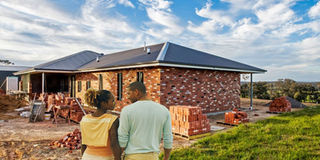Mosquitoes and dust: What to expect as you enter an incomplete house

What you need to know:
There are always many good reasons given for entering one’s house before it is quite finished. In the early days, the disadvantages may threaten to outweigh the positives but there are ways to cope. Here is the when and how to safely enter an incomplete house.
“Just enter as long as there are doors and windows.’ This is a phase you will hear so often when you are building lately. As a matter of fact you will probably have considered this yourself already.
Robert K. Musabe, an electrical engineer and his family of four, wife and two children, entered their incomplete house in January 2019 having begun construction early 2017 after plastering inside and having all doors and windows fixed with glass. There was no water supply at that time and the electricity was partially installed in some of the rooms.
“We were living in a two bedroom rental house for which I was being charged Shs380, 000 per month. On calculating how much the money would contribute to the completion of our own house, we decided to move in since the basics were already in place,” says Musabe.
Ronald B. Ogwang, a software developer and his family of six, three adults and three young ones entered their incomplete house in January 2020. By this time the floor in the entire house was concrete, the walls had been plastered inside, doors and windows glass fixed, the water was installed inside, but there was no electricity, the compound was not levelled yet and there were no trenches or perimeter wall.
“We were able to install the electricity about two weeks after entering because I work a lot from home and need it,” says Ogwang.
Solutions
Getting an electricity connection may take time for several reasons, including long distances from the next connection point, making it expensive to set up poles and get wires extended, especially if you are settling in a new area. Whatever the reason, you will need light and phone charging, among other things so investing in a solar powered connection right from the start, may pay off.
Challenges
“The house is in Bunono Entebbe near Lake Victoria where mosquitos are abundant. Yet also due to the unlevelled compound where sometimes water would stagnate and cause more breeding space for the mosquitos, this became the biggest problem for my family. The ventilators had not yet been wire meshed which made matters even worse,” says Ogwang.
“I remember how my three-year-old would keep telling me ‘dad the mosquitos are too many here but they were not many in the other home’ and I would feel the pressure to do something about it,” Ogwang recalls.
The lockdown in March caused a pause on the construction work due to limitations in movement but also having the children exposed to strangers in such times was not a risk Ogwang was willing to take.
“There was too much dust even though we had put woollen carpets to reduce it and also offer a level of protection for the children against bad falls. I always feared for my gadgets especially the workstation. Every time they swept everything would become dusty,” Ogwang says.
To date, the inconveniences of using the pit-latrines outside, having workers all the time and with little or no privacy given there is still no perimeter wall for the Ogwang’s as construction work, carries on.
Completion takes time
“There is always something to be done and so resources are diversified sometimes which makes the completion work slower than desired. The challenge is that it’s easy to procrastinate finishing when you get used to improvising to make life work in spite of the inconveniences and sometimes the cash does not flow in as expected.” Ogwang says.
The Musabe’s major inconveniences were having to use the pit latrine outside, bushy surroundings because theirs was the first house around many undeveloped plots of land, neighbours being distant, fetching and using unsafe water, lack of privacy due to the ever available workers among many others.
“In addition to the above challenges, insecurity was always on our mind. The house was so exposed with no protective wall fence yet I would go on work trips leaving the family by themselves. It was very disturbing,” Musabe recalls
Musabe’s children are very young and playful. This caused a lot of anxiety to the parents each time construction was on going, exposure to sharp items like nail and other tools was high.
Health hazards
According to Zedekia Mwesigwa Mbeta, an architect at Mweze Construction Company Limited, the most common health hazards expected depending on the level at which the house is incomplete are allergies either developing or being triggered by the dampness, chemicals in the paint and the dust. He adds that here in Uganda especially mosquitos are a big challenge for people that enter incomplete houses.
“Having outside toilets and kitchens is very common in this case and we cannot really ignore the health issues that would be as a result of improper hygiene especially for the children that may not be properly monitored in the absence of the parents.” Mwesigwa adds.
Safely enter an incomplete house
If you are dealing with nuisances such as insecurity and lack of privacy, investing in some extra measures such as raising some guard dogs may be a good step. Also take note of your area security contacts and know how to reach for help, should you need it.
The lack of piped water supply may act as an incentive for you to identify alternatives such as rainwater harvesting.
Minimum standards
The minimum level to consider entering the house where resources are scarce is at least having the house closed, all ventilators if any and all external windows and doors.
“Usually the floor slab takes about 21 days emitting some vapour as it sets after which it continues setting without the emission. It’s safer for one to enter after at least 21 days. The paint also needs about seven days before one can live with it day and night without having any form of allergic reactions to the chemicals contained in the paint.” Mwesigwa says.
According to him not plastering does not really have any health implications but one must make sure the house is dry enough before entering.
Mwesigwa says with the current economic state of the nation entering houses before completion is on the rise because people are trying to figure out how to cut on costs in every way possible.
“An average salary in Uganda is about Shs500, 000 to build a two room and enter in it at the most minimal level of completion one needs not less than Shs8m and yet averagely around Kampala, renting a decent one room is about Shs150, 000, when will such about accumulate a lump sum to finish after struggling to raise the start-up amount?” Mwesigwa wonders.
Many Ugandans start to build when they have families and so the rent is even higher because one needs a bigger house as in the case of Musabe who was paying rent of Shs380, 000 per month.
“Of course people devise means to not only depend on their income when building such as joining Saccos and getting loans but at the end of the day it makes sense that one moves to cut down on the expenditure and the competition work goes on step by step,” says Mwesigwa.





